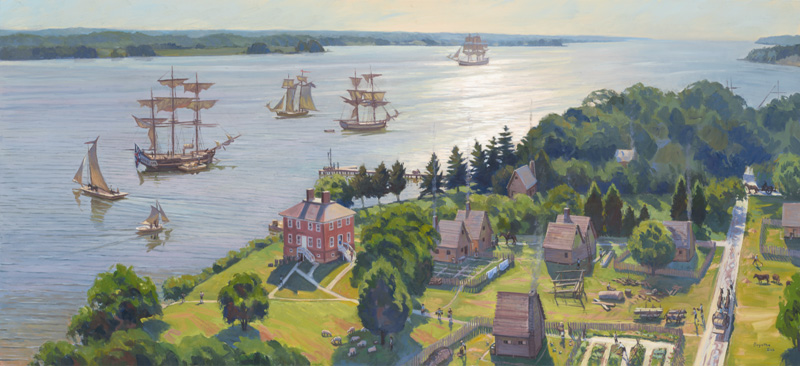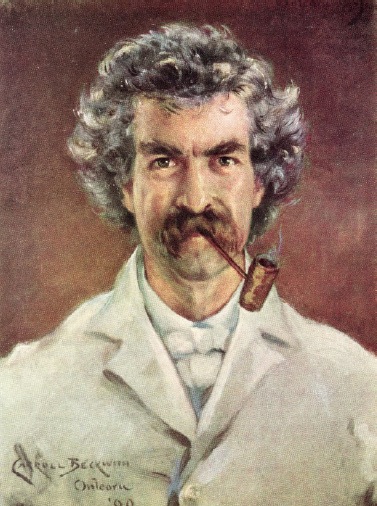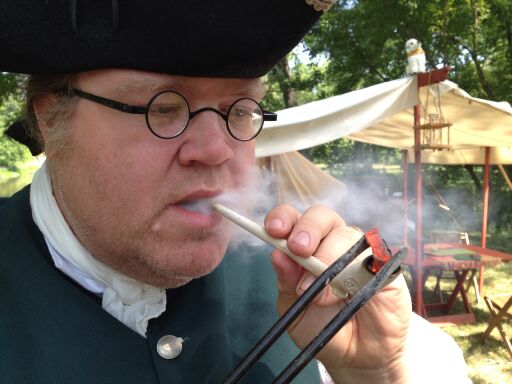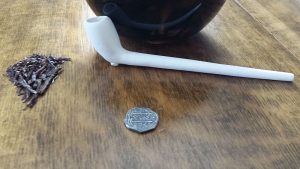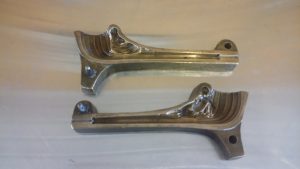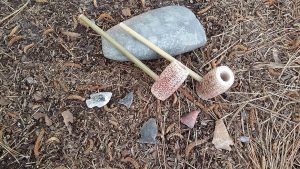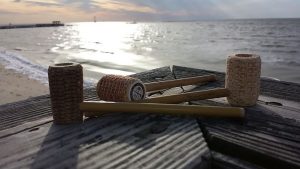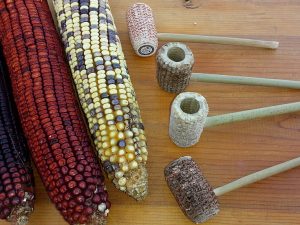If you grow wheat just to get the chaff, you’re crazy…but if you grow corn to get the cob you’re smart.
– Mark Twain
Our area has a rich history of pipe smoking. Both London Town and Annapolis once served as the region’s largest ports for colonial tobacco trade.
We feel an obligation to keep that rich tobacco history alive, so we have researched the prefered tobacco smoking method of that time period, pipe smoking, and have found authentic reproduction smoking pipes that represent that era.
Old Dominion Pipe Company, LLC was founded by two brothers, Bob and Bill Savage, on Virginia’s Eastern Shore. The Eastern Shore of Virginia encompasses the southern tip of the Delmarva Peninsula, a land with a steep tradition in both agriculture and history.
The story of Old Dominion Pipe Company is two-fold. The first critical part of the story centers around the preservation of an heirloom Indian corn that had been grown on the Eastern Shore for over 140 years. Bill Savage discovered this heirloom Indian corn variety that was on the verge of extinction and took efforts to try and preserve this piece of American agricultural history. DNA testing of this heirloom variety revealed that it can be traced back to the “Bloody Butcher” variety grown at the base of the Virginia Blue Ridge Mountains as early as the 1840s. Bill quickly determined that this heirloom corn when ground made a very sweet, and unique textured cornmeal. As a result, he and his wife, Laurel, started Pungo Creek Mills and began harvesting the corn using vintage and antique farm equipment and milling the corn using a restored 1935 Meadows Mills vertical stone grinding mill. In 2010, Pungo Creek Mills won the Best New Food Product Diamond Award at the Virginia Food and Beverage Expo in Richmond, Virginia for their heirloom Indian cornmeal. Pungo Creek Mills heirloom Indian cornmeal continues to gain popularity among amateur cooks and professional chefs alike. As part of the harvesting process, one byproduct that began to accumulate in large piles was rather thick and colorful corn cobs. The size and thickness of these unique cobs (much thicker than modern yellow corn hybrids) began the brothers’ interest in producing a traditional corn cob pipe.
The second half of the story surrounds a fascinating archeological discovery in April 2013. While metal detecting in a recently plowed field, Bob Savage unearthed a forged iron band that proved to be the remnants of a wooden barrel. This rather unassuming iron relic proved to be the key to unlocking a Virginia colonial plantation site with a variety of mid to late 18th century artifacts including a large quantity of clay pipe bowls and stem fragments as well as the charred remnants of actual corn cobs from the 1700s. The pipes uncovered ranged from European manufactured white clay pipes to locally produced red clay pipes. Due to the large amount of domestically produced red clay pipes found on the site, archaeologists hypothesize that these pipes may have actually been made on site. This historic colonial plantation site is undergoing archeological excavation and preservation and is currently closed to the general public in order to preserve the site for further professional archeological exploration. However, once the excavation work has been completed, plans are to set up a museum to house the artifacts recovered on the site and be able to bring to life the story of these early Virginia colonists.
With the discovery of colonial clay pipes as well as the idea that pipes may have actually been produced on the Eastern Shore of Virginia during colonial times, the Savage brothers became even more committed to their idea of not only commercially producing corn cob pipes from their heirloom Indian corn, but to establish a company that would revive traditional smoking pipes from the 18th, 19th, and early 20th centuries. Old Dominion Pipe Company is the realization of their commitment towards this goal
PERIOD AUTHENTIC CLAY PIPES
Old Dominion’s line of clay pipes are quality press molded clay pipes manufactured using a combination of both original and reproduction pipe molds.
Our reproduction molds are copied from original pipe artifacts excavated at a colonial plantation site on our Virginia farm where we grow our heirloom Indian corn. These artifacts were scanned using a 3D scanner, “re-assembled” using computer-aided-design (CAD), and reverse engineered to make a mold using 3D print technology. Using this innovative technique we are able to capture the unique details of the original colonial era clay pipes as they would have come out of the original pipemakers’ molds in the 17th and 18th centuries! The clay we use for our reproductions is a non-toxic, commercially produced clay and our pipes are bisque fired as were the originals.
Our current colonial clay pipe offerings include an early 18th century English clay pipe featuring a decorative spur at the base of the bowl (the “Williamsburg”) and a 17th century red terra cotta “Colono” clay pipe. The “Williamsburg” is named in honor of the renowned 18th century capital of the Virginia Colony (1699-1780). This shorter stemmed version would have been the constant companion for colonial travelers throughout the Colonies as well as British Redcoats and colonial militia on campaign needing a shorter stemmed pipe that was readily compact and less prone to breakage unlike the longer stemmed tavern pipes.
The “Colono” is actually a very unique and somewhat rare 17th century clay pipe that was produced in the Colonies. Often called “Chesapeake” pipes as they are found and believed to have been produced around the Chesapeake Bay region of Virginia and Maryland, these red terra cotta pipes show signs of Native American, English, and even African influence in both design and decoration. One interesting feature of these pipes is the unique geometric decorative designs found on the bowls which are highlighted with white clay giving the pipes a very distinctive look. While many of these pipes were molded by hand, we have chosen to produce ours in a press mold made from 3D scanning a surviving original Colono pipe bowl in our collection. However, like the originals, we apply the decorative design patterns and white clay inlay by hand.
In addition to our reproduction pipe molds, we have been very fortunate to begin acquiring original Victorian era clay pipe molds. These orginial bronze and brass molds (circa 1900) offer both pipe smokers and collectors exact copies of clay pipes that have not been produced for nearly 100 years! With the outbreak of World War I, many of these bronze pipe molds were melted down in order to make shell casings for the war effort. Also, with the cigarette becoming the tobacco product of choice among soldiers on both sides during the war, the clay pipe industry rapidly declined after war’s end.
While we are fortunate to have these molds and be able to put them back in service, serious pipe collectors and historians can rest assured that each pipe we produce bears our own “OD” with crossed pipes logo that is pressed into each and every clay pipe before firing insuring that they are identified as our pipes and cannot be passed off as original antique pipes.
Our initial offering from our original molds is the “Venus” clay pipe. This late Victorian era pipe is press molded from an original European bronze pipe mold and features a semi-nude neoclassical woman reclining against the scallop-shaped bowl and along the narrow stem in a strikingly similar pose to the famous Roman goddess depicted in the well preserved Pompeii fresco at the Casa di Venus, pre 79 A.D. Our rendition of this historic pipe features a red glazed stem tip as had become trendy on clay pipes in the latter half of the 19th and early 20th century. This non-toxic, lead-free glazing offers the pipe smoker a smooth surface area that is not “tacky” or “sticky” to the lips as commonly associated with traditional bisque-fired clay pipes. Although the stem hole is rather small compared to many clay pipes (the original mold requires a fairly narrow wire, approximately 16 ga.) the pipe is smokable and makes the perfect historic pipe whether enjoying your favorite tobacco blend or as an elegant keepsake example of late Victorian era neoclassical art.
These are all fashioned from non-toxic, commercially produced clay, and bisque fired, as were the originals.
HEIRLOOM CORN COB PIPES
 At Old Dominion Pipe Company we are committed to producing only handcrafted traditional smoking pipes that give our customers the true enjoyment of smoking a pipe right out of the pages of history. While many modern pipes employ a variety of plastics, acrylics, and other modern man-made materials, our pipes are painstakingly crafted from only natural materials into proven historically accurate designs.
At Old Dominion Pipe Company we are committed to producing only handcrafted traditional smoking pipes that give our customers the true enjoyment of smoking a pipe right out of the pages of history. While many modern pipes employ a variety of plastics, acrylics, and other modern man-made materials, our pipes are painstakingly crafted from only natural materials into proven historically accurate designs.
Our corn cob pipes feature a natural corn cob bowl handcrafted from an heirloom Indian corn that traces its origins back to the “Bloody Butcher” variety grown at the base of the Virginia Blue Ridge Mountains as early as the 1840s. The color variations in Indian corn carryover in the color of the cobs and cobs are carefully selected so that each pipe bowl is a unique, one-of-a-kind creation. The stem is made from natural bamboo cane as was used in the making of corn cob pipes up through the early 20th century.
Today, in keeping with the legacy of the early pipe makers, Old Dominion Pipe Company proudly embraces the American tradition of using the “reed stem” and introducing it to a whole new generation of pipe smokers. This natural bamboo cane varies slightly from stem to stem due to minor deviations in size and natural imperfections. These minor variations in size and shape give each stem its own unique, original quality. Our bamboo stems are not glued into the cob bowls but rather are individually hand tapered and fitted to each bowl and simply held in place by tension as was the traditional method of securing the stem to the bowl. When purchasing an Old Dominion Indian corn cob pipe, you will truly receive a one-of-a-kind creation, not a mass produced pipe!
While all of our Indian corn cob pipes are designed as functional pipes for use by tobacco pipe smokers, we also realize that non-smokers, who may not have an interest in smoking our pipes, may instead have a sincere interest in collecting them. Our pipes are truly accurate reproductions of traditional corn cob pipes dating back more than 100 years! The pipe makes an interesting souvenir representing an historical artifact of rural Americana and a folk symbol of American culture from the mid 1800s through the turn of the 20th century. Civil War and Western living historians as well as cowboy action enthusiasts will find that our cob pipe can also add an interesting flare to their individual impressions. Our pipes also make historically accurate props for theatrical productions as well as for use in films and documentaries.
Old Dominion Corn Cob Pipes are authentically made — no glues, plastics or varnishes — just corn cob bowls and bamboo reed stems held together with good old fashioned tension.

